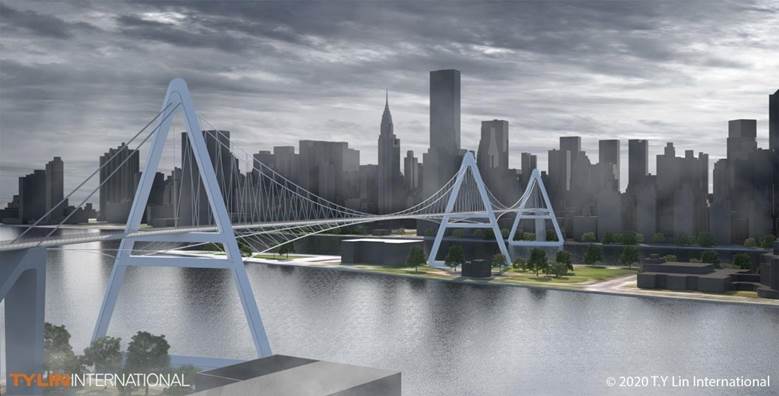Opinion: Gridlock Sam’s Ribbon Bridges Are Growing on Me
The proposed bike/ped spans would help active transportation citywide. In fact, we could use more of them!


Heads swiveled when the engineering firm of Samuel “Gridlock Sam” Schwartz recently floated a proposal for three dedicated bicycle/pedestrian bridges linking Manhattan with Long Island City, Downtown Brooklyn, and New Jersey. The so-called ribbon bridges, named for their lightweight steel construction, would cost about $100 million apiece and would provide a ready solution for the burgeoning number of walking and cycling commuters, carrying 20,000 commuters each daily, Schwartz’s team argued.
The visionary proposal addresses a pressing need: If bike commuting grows as much as many think it will, congestion on the existing bridges “would reach conditions of bike-lock; ultimately many would be forced to walk their bikes; many more would give up.”
Transportation advocates, who for years have worked tirelessly for more room for walkers and bikers on the existing spans into Manhattan, reacted cooly to the proposals, however, citing pandemic-related budget restraints and the need to “keep it simple” (in the words of one).
At first, I agreed with their skepticism — but now, as a Queens-based cyclist, I’m warming to Schwartz’s ideas. Why?
Yes, we can add space for bikes on the Brooklyn Bridge and other bridges, but we also need to plan now for the big challenges ahead.#bikes #pedestrians #Sustainability #Growth #QueensRibon @SamSchwartzEng @nyutandon @TYLI_Group
— GridlockSam Schwartz (@GridlockSam) July 9, 2020
The proposed bridges would cut travel times for some routes, making cycling more desirable and increasing ridership. And they would open up connections among areas that would benefit active transportation citywide. What’s more, I can think of even more places where ribbon bridges would make sense.
For example, some criticized the proposed Queens Ribbon because of its proximity to the 59th Street Bridge — the site of a long struggle to obtain more space for cyclists and pedestrians, who now share a dangerously crowded path.
Utrecht’s Dafne Schippers Bridge follows in the Dutch tradition of working together to find space-efficient design solutions.
An elementary school acts as the on-ramp to a newly-built bike crossing of the Rijn Canal, complete with cycle path on the roof!https://t.co/iHuY5EtxxK pic.twitter.com/cVdvHx68Yk
— Melissa & Chris Bruntlett (@modacitylife) October 2, 2018
But, if its Queens-side entrance hugged the waterfront, the proposed ribbon span might confer some advantages for cyclists seeking more direct routes to Manhattan from the westernmost edge of Queens, including those approaching from Vernon Boulevard in the north and the Pulaski Bridge in the south. The entrance to the Queensboro’s shared bike/pedestrian path lies to the east of those roads, at a (frankly dangerous!) intersection of Crescent Street, so those cyclists now must ride eastward before they can go west across the river.
Similarly, Schwartz’s proposed ribbon bridge connecting Brooklyn and Lower Manhattan would have a central exit at Governors Island — which sits in New York Harbor between the tip of Manhattan and Brooklyn. In that way, it could connect Battery Park and Red Hook, by more or less following the route of the Brooklyn-Battery Tunnel.
Such a bridge would offer new options for bikers and pedestrians going to and from Brooklyn, with an access point further south than the Brooklyn and Manhattan bridges (which connect Downtown Brooklyn and DUMBO to the City Hall area and Chinatown, respectively), and making West Street and the Hudson River Greenway, just around Manhattan’s tip, more easily accessible.
Not only would southwestern Brooklyn benefit, so would users coming from eastern Brooklyn on Eastern Parkway via Grand Army Plaza and Union Street. The possibility of extending cycling opportunities into Manhattan from such neighborhoods as Red Hook, Crown Heights, East New York, and southern Queens — all low-income and/or black and brown areas — is compelling.
Schwartz proposed a Hoboken/Jersey City ribbon bridge across the Hudson to Midtown, but did not specify where he would locate it. It should be the first to be built, however, because such a link doesn’t exist today and because there’s less room to take a lane for cyclists from existing river crossings.

Other gaps in crossings would make good places for ribbons. In between the Williamsburg Bridge (at Delancey Street on the Lower East Side) and the proposed Queens Ribbon (at around 52nd Street), another ribbon could connect Greenpoint in Brooklyn and E.23rd Street. Such a bridge would open access for cyclists from northern Brooklyn but also for those coming from Queens via Greenpoint Avenue, a major (if intermittently dangerous) cycling route.
Schwartz did not propose any Bronx-Queens ribbons, but such connections are needed: Even as Bronx-Queens commuting grows, there is now no legal way to bike the existing crossings. Cyclists have long agitated for legalizing bike riding on the Triboro Bridge, a long span with a narrow shared path; now they may only walk their bikes across it (or risk a ticket if they ride).
Schwartz thinks his ribbon bridges are cheap at the price, especially given that our current crossings allow for very limited future growth of biking. (He also points out that other world cities — including Paris, London, and Amsterdam — have built such infrastructure.) He’s not wrong, considering how we wastefully subsidize free parking, the NYC Ferry, cops, highways, and airports.
Instead, we should keep Fair Fares fully funded, build busways and the Regional Plan Association’s proposed Five Borough Bikeway — and fund these bridges — by means of congestion pricing, parking reform (permits and meters), and other steps. This is #DemandMore as it should be.
Samuel Santaella lives in southeast Queens and volunteers for Riders Alliance and Transportation Alternatives. Follow him on Twitter at @transitninja205.





